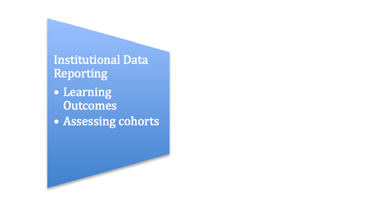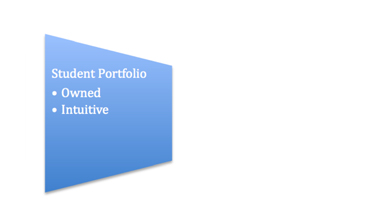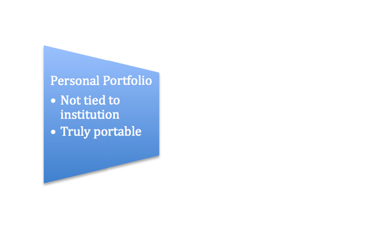Why ePortfolio is the Tool of the Time and Who is Enaaeebling It
As a writing teacher--so, no, the title is not misspelled--who used portfolios in teaching, who served as Chair of the Board of the Mellon-funded Open Source Portfolio Initiative (now part of Sakai), who was an academic computing director involved with rolling out an ePortfolio system, and who is now executive director of the ePortfolio professional association, AAEEBL, I've very obviously hooked my wagon to the set of learning and assessment practices associated with ePortfolios. Now, with over half of all American institutions of higher learning using ePortfolios in one way or another, according to Casey Green's Campus Computing 2008 national survey (www.campuscomputing.net), I could feel my career goal has been met. But, I don't.
Three Kinds of ePortfolio Tools Needed; Two to Go
Why hasn't my portfolio career goal been met? One particular part of ePortfolios has been built out--the part we call assessment management, the institutionally owned reporting process, tracking the progress of student cohorts toward program learning goals. But other parts have not been built out, so the eventual ideal structure of the ePortfolio enterprise is missing really important enabling software applications. For simplicity, let's say there are three main sets of requirements for the ePortfolio stack, as shown below.

--85 percent of the market

--About 15 percent

--Doesn't exist
The Myth of One Platform
Each of these parts of the ePortfolio stack has distinct and largely incompatible requirements. But, the problem is that both vendors and education clients believe these three can be and should be incorporated into one platform. For a number of reasons, including technical ones, this is impossible. The ePortfolio enterprise in the world is stuck with an unworkable belief. Perhaps people believe that since a CMS (or an LMS) is just one app, so an ePortfolio should be.
But this belief makes no sense. There are many purposes for ePortfolios, not just one, and we must have ePortfolio offerings in the three parts of the portfolio stack in order to create better opportunities for full-spectrum learning: authentic, experiential, and evidence-based. Authentic means real-life, doing the actual work, learning-on-the-job, apprenticeship, and so on. This kind of learning requires either the student portfolio, which is in short supply and underdeveloped; or the life-long personal portfolio, which doesn't exist, at least not in the form that people would purchase. At this point, you can show evidence of authentic learning in your ePorfolio only if you are enrolled in a course. In a knowledge culture, this makes no sense. Experiential means doing something that leads to learning, such as service learning--not directly related to a syllabus but often very important for developing the whole person. This part also requires a really good student ePortfolio. Evidence-based means two things: First, evidence must be collected anywhere and, secondly, evidence should be able to find its way to the institutionally owned assessment management system designed for the assessment philosophy of the institution while a person is enrolled in a formal learning program.
Work done outside the classroom, out in real life where learning is happening all the time, can be captured and made visible to present a fuller picture of the learner, not just through the lens of a particular syllabus, but through the panorama of life. Collecting evidence of this work requires the personal, life-long portfolio, the part that doesn't exist yet.
Enter the New ePortfolio Professional Association
We in AAEEBL are encouraged by the ePortfolio work underway in the U.S., Europe, and Australia/New Zealand, but can also see how far we still have to go. [Editor's note: You can see an AAEEBL/EPAC Webcast Thursday May 21, noon Eastern Time, at http://epac.pbworks.com]
We are inspired by many shining examples of good work: at Evergreen College in Washington, at Charleston University in West Virginia, and at anumber of other well-known ePortfolio programs such as Alverno's andLaGuardia's, the University of Michigan cluster of implementations, Indiana University's ground-breaking implementations, the many examples from medical education including that of Case Western Reserve University's new MedicalSchool, the Virginia Tech story, the Ohio Learning Network, Rhode Island's entire K-12 system requiring student use of ePortfolios, the MnSCU and Cal State statewide efforts, the Johns Hopkins story, the impressive portfolio syllabus integration at George Mason's New Century College, portfolios at Queeensland University of Technology in Brisbane, and so on. But, out of the 2,000-plus U.S. institutions using ePortfolios now, we might find only 100 programs where ePortfolio has been implemented with impact on teaching and learning. That's 5 percent. And even those programs are, in many cases, looking for technology improvements.
Therefore, despite these shining examples, the promise of ePortfolios is still a distant glimmer. This is why we have formed a new professional association. One hundred leaders in the ePortfolio world have worked for two years to create AAEEBL, which is affiliated with EPAC, TheInter/National Coalition for Electronic Portfolio Research, IMS Global Learning Consortium, The TLT Group, Helen Barrett's www.electronicportfolios.org, The Association of American Colleges and Universities, and the LaGuardia Community College's ePortfolio initiatives. [See the AAEEBL site (www.aaeebl.org) for more info and links to these affiliated organizations.]
AAEEBL's Purpose
AAEEBL's mission is to bring the fledgling ePortfolio movement toward greater fulfillment of its potential. Current ePortfolio technology offerings are heavily weighted toward the institutional end of the spectrum. AAEEBL will work to galvanize the vendor-educator ePortfolio community to create a broader array of offerings and implementations.